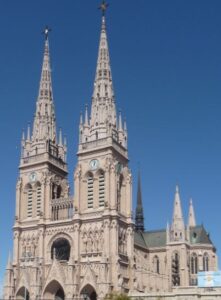10 Famous Cathedrals & Churches In Argentina | Historical Churches In Argentina

- By
- Aparna Patel
- |
- 19 May, 2023
- |
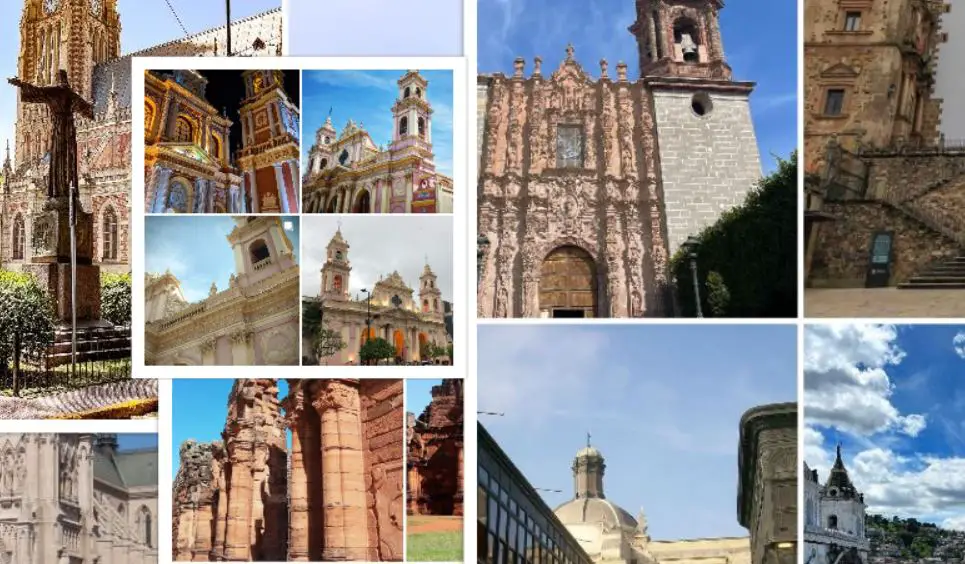
Argentina is a country rich in beautiful churches, cathedrals and chapels, and it is home to some of the most significant historical religious sites in the world. From the towering grandeur of the Metropolitan Cathedral of Argentina in Buenos Aires to the miraculous healing shrine of Our Lady of Lujan, explore some of the most famous historical churches and cathedrals found in Argentina. Learn about their fascinating histories, and discover why they are considered so important to Argentina.
Famous Historical Cathedrals & Churches In Argentina To Visit
1. Cathedral of Salta, Salta
The Cathedral of Salta is a monumental religious building located in the capital city of Salta, Argentina. It was designed by architect Lucio del Valle and finished in 1882, drawing influences from Italian, Neoclassical, and Renaissance architecture. It is one of the most important landmarks in the city and is often referred to as the “Temple of the Sky.”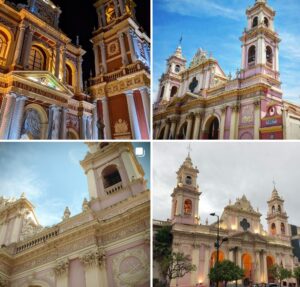
The Cathedral of Salta is constructed of cut stone and is designed as a Latin cross. The main entrance is marked by two robust bell towers, and the interior features intricate designs and artwork. The Cathedral also houses the “Lombardi Baldachin,” which is an ornate canopy crafted from marble, gold, wood, and wrought iron. Many thousands of locals and visitors alike come to admire the cathedral each year. It is sometimes used for special state or religious events and festivals, including the “Folk Festival” which is held annually in July.
2. Iglesia de San Francisco, Buenos Aires
The Iglesia de San Francisco is a church located in Buenos Aires, Argentina. It is the seat of the archdiocese of Buenos Aires. Built in 1794, the church is dedicated to St. Francis of Assisi.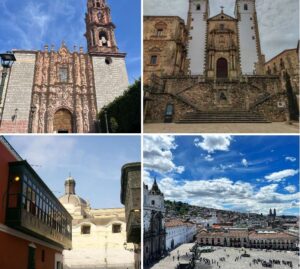
The church is one of the most renowned and popular churches in the city. It is known for its baroque architecture and its impressive golden facade. The interior has a beautiful dome and its side-chapels depict scenes from St. Francis and his life.
The church also houses a number of religious artifacts, including the casket containing the remains of the blessed Fray Jose de Santa Fe. The Iglesia de San Francisco is an important landmark in Buenos Aires and is visited by thousands of people every year.
3. Compañía de Jesús, Buenos Aires
Compañía de Jesús is a religious order in the Catholic Church. It was founded in Spain in 1540 by Saint Ignatius of Loyola. The group’s mission is to spread the teachings of Jesus Christ to the world and to promote service to humanity. The order is often referred to as the Jesuits.
Compañía de Jesús in Buenos Aires, Argentina was founded in 1817 under the direction of Father Juan Antonio Lavalle. Today, Compañía de Jesús maintains two churches in Buenos Aires and does mission work throughout Argentina, Chile, and Uruguay. The order works with a variety of social programs to help the poor and disadvantaged, as well as operating four educational institutions. It is also involved in politics and social justice issues.
4. San Ignacio Miní, Cordoba
San Ignacio Miní is a town located in the province of Córdoba, in the northern center of Argentina. It is the capital of the department of Cañada de Luque, and it is situated west of the city of Córdoba.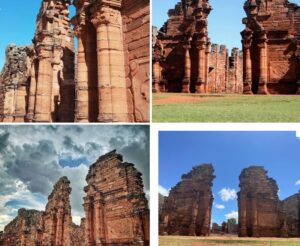
San Ignacio Miní is known for its colonial-style architecture and its traditional celebrations, such as the Feast of Our Lady of the Purísima Concepción (on December 8th) and the San Ignacio Fiesta (celebrated on the first weekend of May). The town is also known for its cultural, religious, educational, and touristic sites, such as the San Ignacio Miní Museum, the Nueva Cadiz Historical Site, and the Nuestra Señora de los Ángeles Sanctuary. San Ignacio is the birthplace of General San Martín, the Argentinian military leader who liberated South America from Spanish rule in the early 1800s.
San Ignacio Miní is an ideal destination for nature lovers, as it is surrounded by beautiful landscapes, lush forests, and flowing rivers. Its biodiversity is both extensive and varied, with cacti, bromeliads, and even some endangered species, such as the red macaw. Moreover, San Ignacio is located in a humid subtropical climate zone, with mild temperatures and plenty of sunshine throughout the year.
5. Catedral de San Isidro, Buenos Aires
The Catedral de San Isidro is a Roman Catholic cathedral located in Buenos Aires, Argentina. It is dedicated to Saint Isidore the Laborer, the patron saint of Madrid, and the work of consecrating its foundations began in 1706 with the donation of land by Spanish viceroy Matías de Gálvez.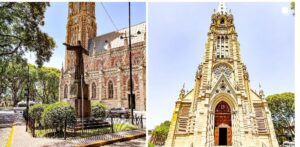
The building was consecrated in 1758 and it remains as one of the oldest and most important landmarks of the city. The structure stands at the side of the Plaza San Martín and features Baroque style architecture with a Baroque interior which has been preserved for its originality.
The Catedral de San Isidro is a popular destination for tourists and locals alike, as it is frequented for its religious and cultural heritage as well as its importance in the history of Argentina. This includes its use as a venue for large scale festivals and national events, such as the inaugural Mass prior to the 1998 world cup, held within the Catedral de San Isidro.
6. Iglesia de Nuestra Señora de la Merced, Buenos Aires
Iglesia de Nuestra Señora de la Merced is a Baroque-style Catholic church in the port city of Buenos Aires, Argentina. Built in 1740, it is one of the oldest surviving churches in the city and is a popular tourist attraction. The church is located in the Plaza de la Merced, a major square in the city. Built of sandstone, the Iglesia de Nuestra Señora de la Merced has remained a symbol of faith and tradition for centuries.
The church features a double-tiered bell tower, which stands at the center of the structure, and has a single central nave. Inside, the church features a wooden carved altar and several beautiful Baroque-style paintings and sculptures. The steeple of the church is topped with a large bronze cross and the interior is illuminated by several large stained-glass windows.
The Iglesia de Nuestra Señora de la Merced is a regular place of worship and is open to visitors every day of the year. Free guided tours are available for visitors and the church also hosts numerous religious events and services throughout the year.
7. Iglesia de Nuestra Señora de Belén, Misiones
Iglesia de Nuestra Señora de Belén is a Roman Catholic church located in the city of Misiones in Argentina. It belongs to the Jurisdiction of the Diocese of Misiones. It was built in 1872 and was consecrated in 1873. It is one of the most beautiful historical monuments in Misiones, and its design honors the architect Bartolomé Cáceres. The church is located in a large park which is perfect for strolls and walking the dog.
The church is known for its neo-gothic style and the stained glass windows. The façade and bell tower are both made of adobe bricks and are painted white and yellow. Inside, there is an Italian organ, a main altar with sculptures, and other smaller alters with religious icons.
The church has been declared a National Historic Landmark by the National Institute of Patrimony and is one of the most visited places in Misiones. The church and its inspiring architecture are a great way to learn about the local history. If you are in Misiones, be sure to visit Iglesia de Nuestra Señora de Belén.
8. Basílica de Nuestra Señora de Luján, Buenos Aires
Basílica de Nuestra Señora de Luján (Our Lady of Luján Basilica) is a Roman Catholic church located in the center of Buenos Aires, Argentina. Built between 1745 and 1772, the church is the main center of the veneration of the Virgin of Luján. It is the largest religious building in the country and the most important of its kind in the American continent.
The church was built by the Capuchin order of Franciscans, at the request of the Viceroy of the Río de La Plata, on the banks of the Lujano River. The site of the basilica was chosen because of its excellent natural conditions and its strategic location.
The architectural style of the church is based on baroque and late-baroque styles, with rococo and neoclassical influences. The interior of the church is decorated with Baroque style frescoes and paintings, and the structure is composed of several naves that lead to the main altar, where the image of the Virgin of Luján is venerated.
The Basilica de Nuestra Señora de Luján is one of the most popular places of pilgrimage in the country. Every year on October 8th, during the festival of the Virgin of Luján, hundreds of thousands of people come from all over Argentina to attend a mass in the basilica. The festival is a national holiday in Argentina and a major celebration for the entire Latin American community.
9. Catedral de San José, Corrientes
The Cathedral of San José is the main Catholic Church in Corrientes, Argentina. It was constructed in the 19th century and is located in the city center. The building stands in the Main Plaza in Corrientes, and the Plaza is often referred to as the “Plaza of the Cathedral”. The structure was designed by Italian architect Vicenzo Ricci and constructed between 1835 and 1886.
The cathedral was started during the period of Manuel Belgrano’s rule of Corrientes, and the original style was neoclassical in nature. However, the cathedral underwent several renovations, and it received its current Baroque look in the late 19th century.
The overall design of the structure contains a combination of different architectural styles such as Renaissance, Baroque and Neoclassical. The main façade is characterized by several domes and two levels of windows. The upper part of the façade has four Greek columns, while the lower one has two free-standing Tuscan columns.
Inside the cathedral, visitors can admire the stunning high ceilings and tall stained-glass windows. The marble altar piece and various statues give the place a very spiritual feeling.
The historical church also has a crypt, a bell tower and a small chapel. Additionally, there is a museum inside the church that features memorabilia from previous centuries. The church remains a popular and important venue in Corrientes and visitors can attend regular religious services in the cathedral.
10. Iglesia de San Lorenzo de Misiones, Misiones
The Iglesia de San Lorenzo de Misiones is a historic church located in the province of Misiones in Argentina. It is one of the oldest churches in this area, having been built in 1821 and renovated in 1994.
The church is currently a historical monument in the province, protected by the Provincial Historical Patrimony Institute.
The church is designed in a Baroque style, and features a two-story structure with several domes and intricate stonework. It is adorned with several sculptures, paintings, and stained glass windows.
Inside the church, one can find several religious frescoes, which represent various themes such as the Virgin Mary and Jesus Christ. The Iglesia de San Lorenzo de Misiones and its surrounding plaza are a popular tourist attraction for people interested in colonial architecture in Argentina.
Search Posts
Latest posts
-
4 Mar, 2024
Can I accidentally miss the in-flight food?
Popular posts
-
5 Mar, 2024
Why prohibit engine braking?
-
5 Mar, 2024
How to avoid drinking vodka?
